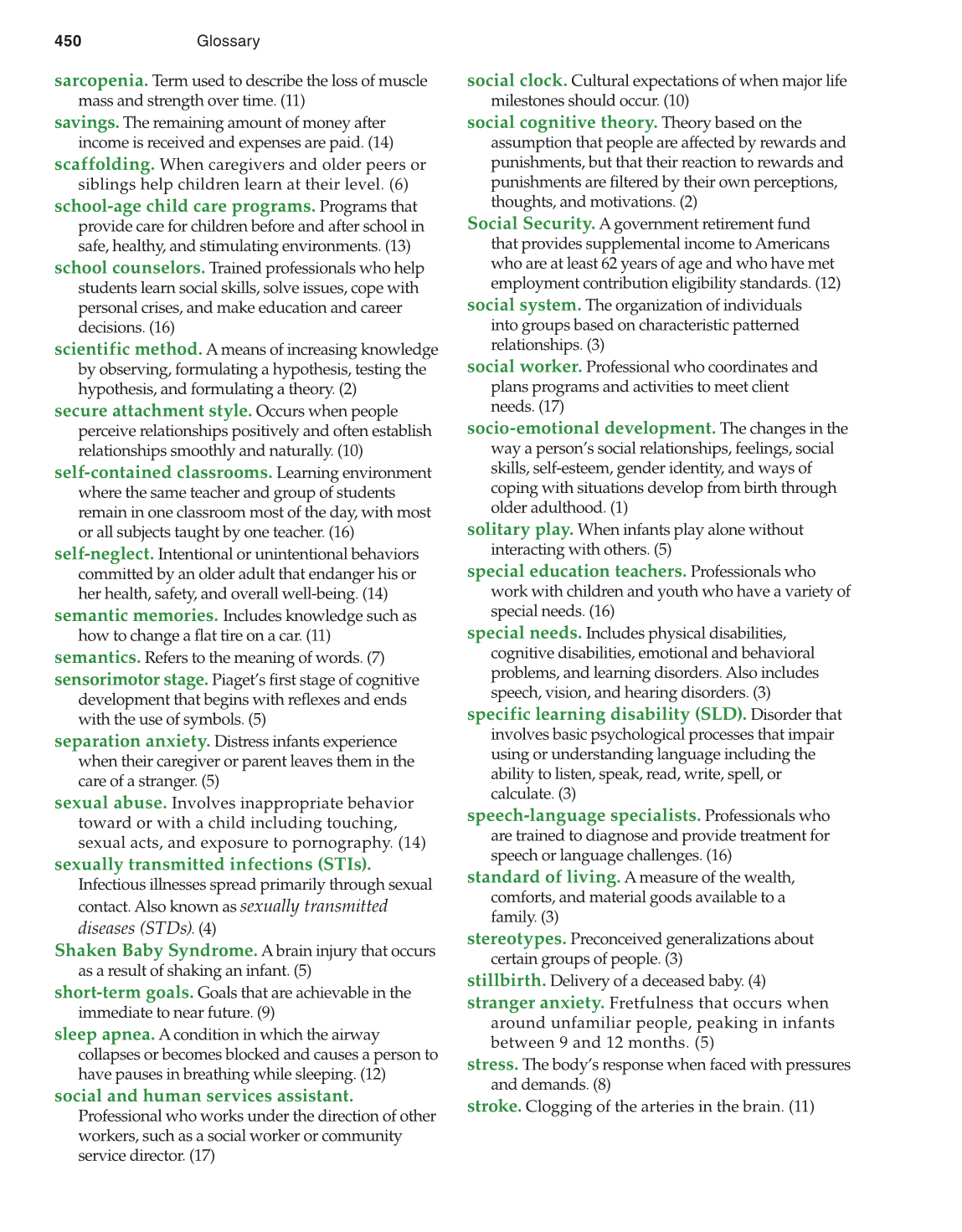450 Glossary
sarcopenia.
Term used to describe the loss of muscle
mass and strength over time. (11)
savings.
The remaining amount of money after
income is received and expenses are paid. (14)
scaffolding.
When caregivers and older peers or
siblings help children learn at their level. (6)
school-age child care programs.
Programs that
provide care for children before and after school in
safe, healthy, and stimulating environments. (13)
school counselors.
Trained professionals who help
students learn social skills, solve issues, cope with
personal crises, and make education and career
decisions. (16)
scientific method.
A means of increasing knowledge
by observing, formulating a hypothesis, testing the
hypothesis, and formulating a theory. (2)
secure attachment style.
Occurs when people
perceive relationships positively and often establish
relationships smoothly and naturally. (10)
self-contained classrooms.
Learning environment
where the same teacher and group of students
remain in one classroom most of the day, with most
or all subjects taught by one teacher. (16)
self-neglect.
Intentional or unintentional behaviors
committed by an older adult that endanger his or
her health, safety, and overall well-being. (14)
semantic memories.
Includes knowledge such as
how to change a flat tire on a car. (11)
semantics.
Refers to the meaning of words. (7)
sensorimotor stage.
Piaget’s first stage of cognitive
development that begins with reflexes and ends
with the use of symbols. (5)
separation anxiety.
Distress infants experience
when their caregiver or parent leaves them in the
care of a stranger. (5)
sexual abuse.
Involves inappropriate behavior
toward or with a child including touching,
sexual acts, and exposure to pornography. (14)
sexually transmitted infections (STIs).
Infectious illnesses spread primarily through sexual
contact. Also known as
sexually transmitted
diseases (STDs).
(4)
Shaken Baby Syndrome.
A brain injury that occurs
as a result of shaking an infant. (5)
short-term goals.
Goals that are achievable in the
immediate to near future. (9)
sleep apnea.
A condition in which the airway
collapses or becomes blocked and causes a person to
have pauses in breathing while sleeping. (12)
social and human services assistant.
Professional who works under the direction of other
workers, such as a social worker or community
service director. (17)
social clock.
Cultural expectations of when major life
milestones should occur. (10)
social cognitive theory.
Theory based on the
assumption that people are affected by rewards and
punishments, but that their reaction to rewards and
punishments are filtered by their own perceptions,
thoughts, and motivations. (2)
Social Security.
A government retirement fund
that provides supplemental income to Americans
who are at least 62 years of age and who have met
employment contribution eligibility standards. (12)
social system.
The organization of individuals
into groups based on characteristic patterned
relationships. (3)
social worker.
Professional who coordinates and
plans programs and activities to meet client
needs. (17)
socio-emotional development.
The changes in the
way a person’s social relationships, feelings, social
skills, self-esteem, gender identity, and ways of
coping with situations develop from birth through
older adulthood. (1)
solitary play.
When infants play alone without
interacting with others. (5)
special education teachers.
Professionals who
work with children and youth who have a variety of
special needs. (16)
special needs.
Includes physical disabilities,
cognitive disabilities, emotional and behavioral
problems, and learning disorders. Also includes
speech, vision, and hearing disorders. (3)
specific learning disability (SLD).
Disorder that
involves basic psychological processes that impair
using or understanding language including the
ability to listen, speak, read, write, spell, or
calculate. (3)
speech-language specialists.
Professionals who
are trained to diagnose and provide treatment for
speech or language challenges. (16)
standard of living.
A measure of the wealth,
comforts, and material goods available to a
family. (3)
stereotypes.
Preconceived generalizations about
certain groups of people. (3)
stillbirth.
Delivery of a deceased baby. (4)
stranger anxiety.
Fretfulness that occurs when
around unfamiliar people, peaking in infants
between 9 and 12 months. (5)
stress.
The body’s response when faced with pressures
and demands. (8)
stroke.
Clogging of the arteries in the brain. (11)
